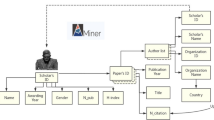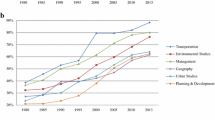Abstract
It is shown that winners of the A. M. Turing Award or the John von Neumann Medal, both of which recognize achievement in computer science, are separated from some other A. M. Turing Award or John von Neumann Medal winner by at most 1.4 co-authorship steps on average, and from some cross-disciplinary broker, and hence from some discipline other than computer science, by at most 1.6 co-authorship steps on average. A. M. Turing Award and John von Neumann Medal recipients during this period are, therefore, on average closer in co-authorship terms to some other discipline that typical computer scientists are, on average, to each other.









Similar content being viewed by others
Notes
See http://amturing.acm.org/call_for_nominations.cfm; accessed Jan, 2015.
See http://www.ieee.org/about/awards/awards_guidelines.html; accessed Jan, 2015.
http://www.oakland.edu/enp/erdpaths/; accessed Jan, 2015.
http://amturing.acm.org/; accessed Nov–Dec, 2014.
http://www.ieee.org/about/awards/medals/vonneumann.html; accessed Jan. 2015.
http://dblp.uni-trier.de/db/; accessed Jan, 2015.
http://www.oakland.edu/enp/erdpaths/, accessed Jan, 2015.
References
Barabási, A. L., Jeong, H., Neda, Z., Ravasz, E., Schubert, A., & Vicsek, T. (2002). Evolution of the social network of scientific collaborations. Physica A, 311, 590–614.
Bozorth, R. M., & Hamming, R. W. (1953). Measurement of magnetostriction in single crystals. Physical Review, 89, 865–869.
Cabanac, G., Hubert, G., & Milard, B. (2015). Academic careers in computer science: Continuance and transience of lifetime co-authorships. Scientometrics, 102, 135–150.
Chakraborty, T., Sikdar, S., Ganguly, N., & Mukherjee, A. (2014). Citation interactions among computer science fields: A quantitative route to the rise and fall of scientific research. Social Network Analysis and Mining, 4(1), 187. doi:10.1007/s13278-014-0187-3.
Corbato, F. J., & Switendick, A. C. (1963). Integrals for diatomic molecular calculations. In B. Alder, S. Fernbach, & M. Rotenberg (Eds.), Methods in computational physics (Vol. 2). New York: Academic Press.
De Castro, R., & Grossman, J. W. (1999). Famous trails to Paul Erdős. Mathematical Intelligencer, 21(3), 51–53.
De Solla Price, D. (1963). Little science, big science. New York: Columbia University Press.
Elmacioglu, E., & Lee, D. (2005). On six degrees of separation in DBLP-DB and more. SIGMOD Record, 34(2), 33–40.
Fields, C. (1996). Informatics for ubiquitous sequencing. Trends in Biotechnology, 14, 286–289.
Fields, C. (2014). Some effects of the human genome project on the Erdős collaboration graph. Journal of Humanistic Mathematics, 4(2), 3–24.
Fields, C. (2015a). How small is the center of science? Short cross-disciplinary cycles in co-authorship graphs. Scientometrics, 102, 1287–1306.
Fields, C. (2015b). Close to the edge: Co-authorship proximity of Nobel laureates in Physiology or Medicine, 1991–2010, to cross-disciplinary brokers. Scientometrics,. doi:10.1007/s11192-015-1526-5.
Franceschet, M. (2010). The role of conference publications in CS. Communications of the ACM, 53(12), 129–132.
Freyne, J., Coyle, L., Smyth, B., & Cunningham, P. (2010). Relative status of journal and conference publications in computer science. Communications of the ACM, 53(11), 124–132.
Ganapathiraju, M., Balakrishnan, N., Reddy, R., & Klein-Seetharaman, J. (2008). Transmembrane helix prediction using amino acid property features and latent semantic analysis. BMC Bioinformatics, 9(Suppl 1), S4. doi:10.1186/1471-2105-9-S1-S4.
Glänzel, W., & Rousseau, R. (2005). Erdős distance and general collaboration distance. ISSI Newsletter, 1(2), 4–5.
Grossman, J. (2005). Patterns of research in mathematics. Notices of the AMS, 52(1), 35–41.
Jacobs, J. A., & Frickel, S. (2009). Interdisciplinarity: A critical assessment. Annual Review of Sociology, 35, 43–65.
Kanehisa, M., Fickett, J. W., & Goad, W. B. (1984). A relational database system for the maintenance and verification of the Los Alamos sequence library. Nucleic Acids Research, 12, 149–158.
Klavans, R., & Boyack, K. W. (2009). Toward a consensus map of science. Journal of the American Society for Information Science and Technology, 60, 455–476.
Lederberg, J., Sutherland, G. L., Buchanan, B. G., Feigenbaum, E. A., Robertson, A. V., Duffield, A. M., & Djerassi, C. (1969). Applications of artificial intelligence for chemical inference. I. Number of possible organic compounds. Journal of the American Chemical Society, 91, 2973–2976.
Lennard-Jones, J. E., Wilkes, M. V., & Bratt, J. B. (1939). The design of a small differential analyser. Mathematical Proceedings of the Cambridge Philosophical Society, 35, 485–493.
Meinhardt, H. (2009). Models for the generation and interpretation of gradients. Cold Spring Harbor Perspectives in Biology, 1, a001362.
Newman, M. E. J. (2001). The structure of scientific collaboration networks. Proceedings of the National Academy of Sciences USA, 98, 404–409.
Rosenblatt, F. (1958). The perceptron: A probabilistic model for information storage and organization in the brain. Psychological Review, 65, 386–407.
Shortliffe, E. H., Axline, S. G., Buchanan, B. G., Merigan, T. C., & Cohen, N. (1973). An artificial intelligence program to advise physicians regarding antimicrobial therapy. Computers and Biomedical Research, 6, 544–560.
Stormo, G. D., Schneider, T. D., Gold, L., & Ehrenfeucht, A. (1982). Use of the ‘Perceptron’ algorithm to distinguish translational initiation sites in E. coli. Nucleic Acids Research, 10, 2997–3011.
Sugimoto, C. & Weingart, S. (2015). The kaleidoscope of disciplinarity. Preprint (http://ella.slis.indiana.edu/~sugimoto/preprints/KaleidoscopeOfDisciplinarity.pdf. Accessed Jan 2015).
Turing, A. M. (1952). The chemical basis of morphogenesis. Philosophical Transactions of the Royal Society of London B Biological Sciences, 237, 37–72.
Xing, E. P., & Karp, R. M. (2001). CLIFF: Clustering of high-dimensional microarray data via iterative feature filtering using normalized cuts. Bioinformatics, 17(Supp 1), S306–S315.
Author information
Authors and Affiliations
Corresponding author
Rights and permissions
About this article
Cite this article
Fields, C. Co-authorship proximity of A. M. Turing Award and John von Neumann Medal winners to the disciplinary boundaries of computer science. Scientometrics 104, 809–825 (2015). https://doi.org/10.1007/s11192-015-1575-9
Received:
Published:
Issue Date:
DOI: https://doi.org/10.1007/s11192-015-1575-9




